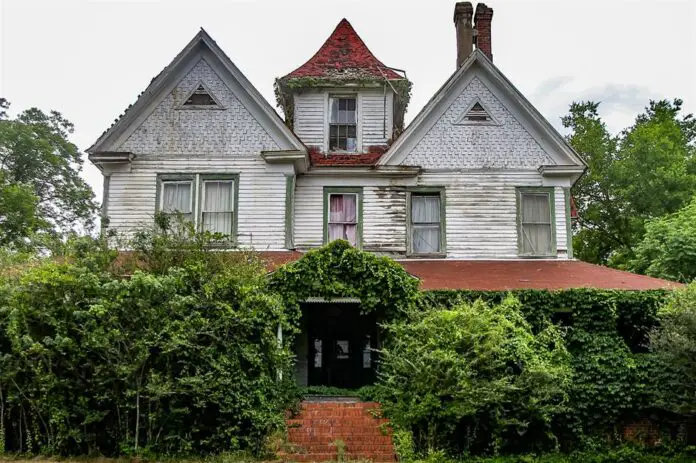This fascinating Georgian home, tucked away on a forested lot and covered in vegetation, has a fascinating tale to tell. Leland Kent of Abandoned Southeast photographed the property in the early 20th century. It passed through various owners before being purchased by a Mr. John McCown in 1967.
Both adored and despised, McCown had a significant impact on the history of the area and helped transform the house into the landmark it is today. Enter to discover more about its tumultuous past.

The dilapidated facade of the home indicates that it has been neglected for many years. Some window panes are missing, and the once-imposing central tower is starting to crumble. The building has been reclaimed by Mother Nature, with vegetation clinging to the porch roof and creeping through the lowest floor.

Inside, the situation is similar: a thick layer of black mold covers the walls, and sections of the ceiling are collapsing. Even yet, the estate retains much of its past splendor; the exquisite parquet ceiling attests to the previous owners’ wealth, and the spectacular tongue-and-groove woodwork is remarkably well-kept.

Born in 1934 in South Carolina and raised in Harlem, John McCown was a somewhat controversial man. When he bought the site in 1967, he was already deeply involved in the black civil rights movement, having spearheaded the historic first civil rights march in Colorado Springs and going on to collaborate with the Congress of Racial Equality (CORE).

McCown’s tastes are evident in the deteriorating main area décor of his former home. Although the wallpaper with its red and blue paisley design may seem bold today, it was a huge style in the 1970s. The mantel has been decorated with haut-relief sculptures and a beveled glass mirror, while the fireplace has been bricked over.

The coffered ceiling is still intact, but the wallpaper is peeling off to reveal exposed wood planks. At the age of 33, McCown moved into the property after accepting a position as executive director of the Georgia Council on Human Relations and traveling to Hancock County to assist with black voter registration. Nearly half of the black population lived below the poverty line, making it one of the poorest areas of the country at the time.

Ascending the steps reveals debris all across the area and damp spots on the walls, a far cry from its former golden grandeur. To better the lot of African Americans in Hancock County, McCown founded the Eastern Central Committee for Opportunity (ECCO) in the early 1970s. A few years later, the group had secured millions of dollars in government and private money, and with McCown’s help, Hancock County became the first area in Georgia to elect a board of county commissioners with a majority of black voters.

Even with its ostentatious decorations, the abandoned estate maintains McCown’s air of luxury. Over the years, the campaigner is said to have acquired hundreds of acres of land and several additional houses. With finely carved balusters and newels, this white-painted staircase is a unique architectural feature that has remarkably withstood the test of time.





















